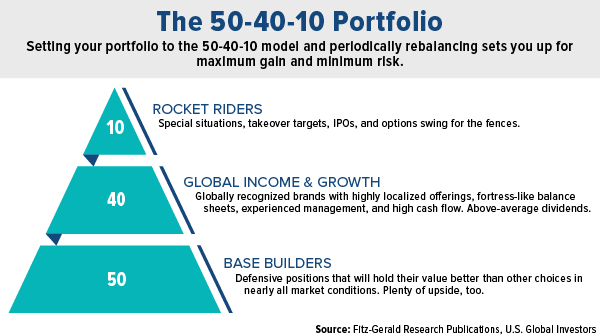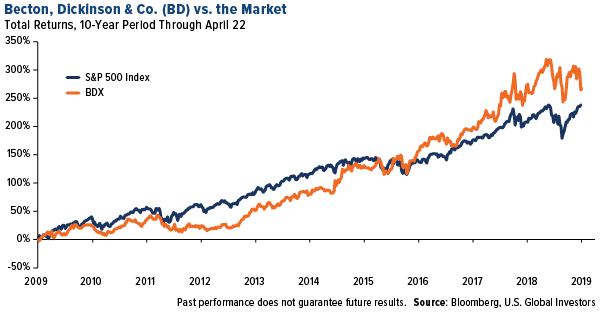If you’re as much a consumer of financial news as I am, chances are very good you’ve seen Keith Fitz-Gerald as a regular contributor on Fox Business, CNBC and elsewhere. That, or read his invaluable market commentary online.Nothing beats catching him in person, though, and I highly advise you do so if you get the opportunity.Part investment guru, part motivational speaker, Keith manages to make you feel as if you can conquer the world… and have a great time doing it. I’ve had the privilege of seeing him present a number of times before—most recently at Money Map Press’ Black Diamond Conference in Delray Beach, Florida—and I’m always in awe not just of his depth of market knowledge but also the amount of energy he brings to the table.The longtime writer of the popular Money Map Report and High Velocity Profits newsletters, Keith was gracious enough to chat one-on-one with me recently. Below are highlights from our conversation, during which we touched on a number of topics ranging from portfolio construction to the similarities between investing and the martial arts. You have a unique story about how you first got interested in investing. If I remember, it began with your grandmother. Thanks for remembering! We all called her Mimi. She was widowed at a very young age and turned a small life insurance settlement into everything she needed to live out the rest of her life and then some. She became a global investor long before that term even existed. When I turned 15, Mimi didn’t give me the usual books or sweaters other teenagers might have received. Instead, she got me subscriptions to Value Line and Forbes , and every Sunday afternoon we would meet over martinis and ham sandwiches to talk about the markets.Mimi wanted me to understand that the world was much bigger than my garage. Our discussions weren’t necessarily about investing, but about the companies, products and services that were changing the world I would inherit. We talked about how and why that mattered and, of course, how to invest in markets that would change dramatically during my investing lifetime.She often used to say “Get out there and see it.” Mimi traveled all over the world as a means of vetting her investments and that’s a habit I’ve kept up to this day. Eventually, Mimi got so good at translating what she saw into investment ideas that the Merrill Lynch brokers she worked with used to call her and ask for her thoughts.Mimi was an exceptionally bright and astute observer of the world around her. Yet, at the same time, she was a very humble person. I miss her today but have no doubt she’s out there watching the markets carefully and looking, as she always did, ahead for cues as to what’s next.Hopefully, those are traits that I’ve picked up. I am a big believer in “boots on the ground” when it comes to exploring potential investments. I’ve traveled widely all over the planet over the past 36 years, often on my motorcycle with my wife. I want to see the world around me so I can accurately ascertain where the best opportunities are because there is no proxy for firsthand knowledge. Speaking of your wife… I understand she has two black belts? What’s that like? That’s right, she does. I’ve been doing martial arts since I was 15 years old, and Noriko’s been doing it since she was about five, so we’re a good match. Practically speaking, I don’t worry very much about home security if she’s on the case! Noriko’s the love of my life and we’ve been together nearly 24 fabulous years.Many people don’t realize that the martial arts are not about defense or even attack. Instead, they’re really about personal growth and character—who you are as a person. One of the very first things you learn when you obtain a black belt, for example, is just how much you don’t know. In the Western world people commonly believe that a person with a black belt knows everything and must therefore be an expert. Yet, the first time you put one on, you realize just how much you don’t know and what a student of life you have become. In that sense, a black belt is really another door opening… to more advance and highly personal learning. And having married Noriko, and being exposed to the martial arts, and subsequently my life in Japan over the last 30-something years, I very much have that mindset. It sounds like there’s a lot of crossover between martial arts and investing. Absolutely. I think about that every day, in fact. I’ll give you a great example. There’s a Japanese proverb—and I’m paraphrasing here—the bamboo that bends is stronger than the oak that resists. That’s just as true in martial arts as it is in the markets. If you try to block a punch or a kick straight on, chances are you’re going to have to take the blow and risk getting hurt. But redirect that energy or sidestep it before impact, and now you’ve got the upper hand.Investing is very similar. You will lose money if you remain inflexible. Success and big profits come from constantly adapting to changing conditions rather than trying—as a lot of investors do—to second-guess the unguessable. You’ve been in the capital markets for a while now. What’s the hardest lesson you’ve had to learn during that time? That’s an interesting question with many possible answers. However, if I had to choose just one, the single toughest lesson is learning to pay attention to the environment around you. And I don’t just mean reading the headlines or the internet either. I mean really becoming a student of what’s happening around you and why.You can’t ignore the past like a lot of investors do. History won’t repeat, but it rhymes, and the markets have a very defined upward bias, which means that you can align your money with some really super profit potential if you understand how, why and where the move “fits.” The other thing people don’t realize, because they get so focused on the trees that they cannot see the forest, is that the financial markets have a very defined preference for moving forward. That’s why there are future-looking valuation methods. And if you’re trapped in the past making decisions on data that’s based solely on the past, on emotion, on stuff that should be in the rear-view mirror, you’re going to miss the opportunities.Related: Gold Mining Stocks Are Surging on Global Economic Fears You’re known for the 50-40-10 portfolio, among other things. Describe that for us. Thanks for pointing that out. Let me start by saying that conventional thinking about diversification is, I believe, badly flawed. The theory is a lot like throwing spaghetti against a wall and seeing what sticks. The proposition is that you have lots of great stocks that don’t go up and down at the same time, but the reality is that it’s more like rearranging the deck chairs on the Titanic in today’s highly computerized markets, when correlation is higher than it’s been at any point in financial history.If you want to get ahead and diversify your portfolio, the irony is that you don’t spread it all over. You don’t, for example, see buildings named after “diversifiers,” but you do see ‘em named after people who have made a boatload by taking well-reasoned, calculated risks. If you can do that, the returns—the giant profits, really—will come.The simplest way to describe the 50-40-10 portfolio is to think of your money like a food pyramid. The stuff at the bottom is what I call the “50”—the 50 percent, the Base Builders—that’s like the stuff your mother told you to eat even though it tastes like wallpaper because it’s good for you. The stuff in the middle, the 40 percent, is what I call Global Income and Growth. That’s the stuff that you wouldn’t mind having another helping of because it actually tastes good and it’s good for you and your money. But then you get to the 10 percent, the Rocket Riders. That’s the chocolate ice cream, the beer, the chips—whatever your favorite indulgence is.This structure gives you unprecedented stability, lowers your risk… yet keeps you profit-oriented at all times even in market conditions that send other investors packing.




 click to enlarge
click to enlarge